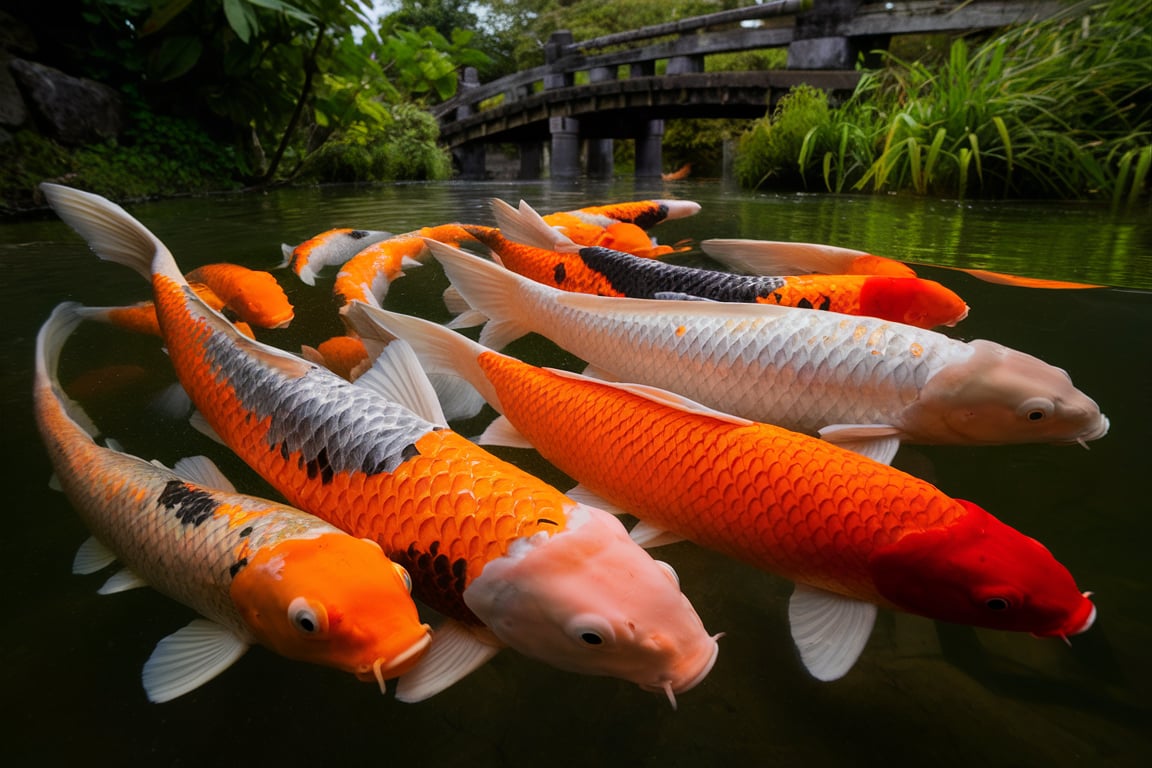Koi fish, with their vibrant colors and elegant movements, are a beloved sight in ponds and water gardens worldwide. But where did these captivating creatures originate? The story of koi fish origin is a fascinating journey that spans centuries and continents, intertwined with cultural significance and selective breeding. Let’s follow Love My Koi!
From Humble Carp to Exquisite Koi: A Journey of Domestication
The journey of koi fish begins with the common carp, Cyprinus carpio, a species native to Asia. These carp, originally found in the rivers and lakes of Central Asia, were valued for their meat and were widely distributed throughout Asia.

The Rise of Koi in Japan
The story of koi fish as we know them today begins in Japan. It is believed that the first koi fish were bred in the early 19th century in the Niigata Prefecture of Japan. Japanese breeders, fascinated by the natural color variations within carp populations, began selectively breeding carp with desirable traits, such as vibrant colors and patterns. This selective breeding process, over generations, led to the development of the diverse and stunning varieties of koi fish we see today.
The Significance of Koi in Japanese Culture
Koi fish hold a special place in Japanese culture, symbolizing good fortune, perseverance, and strength. They are often associated with the legend of the “Golden Carp,” which, according to legend, swam upstream against strong currents and transformed into a dragon. This legend reinforces the symbolism of koi as a symbol of ambition, determination, and success.
The Spread of Koi Fish Beyond Japan
Koi fish quickly gained popularity beyond Japan, spreading to other parts of Asia and eventually to the West. Their beauty and cultural significance made them a desirable addition to ponds and water gardens around the world.
Koi Fish in Vietnam
Koi fish are also popular in Vietnam, where they are often raised in ponds and used for ornamental purposes. Vietnamese breeders have also developed their own unique varieties of koi fish, reflecting the country’s rich cultural heritage.
Key Varieties of Koi Fish
Over centuries of selective breeding, numerous varieties of koi fish have been developed, each with its own unique characteristics and color patterns. Some of the most popular varieties include:
1. Kohaku:
- Origin: Japan
- Characteristics: White body with red markings, often with a distinct red “head” pattern.
- Symbolism: Represents purity and good fortune.
2. Taisho Sanshoku:
- Origin: Japan
- Characteristics: White body with red and black markings.
- Symbolism: Represents harmony and balance.
3. Showa Sanshoku:
- Origin: Japan
- Characteristics: Black body with red and white markings.
- Symbolism: Represents strength and resilience.
4. Bekko:
- Origin: Japan
- Characteristics: Black body with white or yellow markings.
- Symbolism: Represents elegance and sophistication.
5. Utsurimono:
- Origin: Japan
- Characteristics: Black body with white, red, or yellow markings.
- Symbolism: Represents diversity and individuality.
Frequently Asked Questions About Koi Fish Origin
1. Where are koi fish originally from?
Koi fish originated from the common carp, Cyprinus carpio, which is native to Central Asia. However, the modern varieties of koi fish were developed in Japan through selective breeding.
2. When were koi fish first bred?
The first koi fish are believed to have been bred in the early 19th century in the Niigata Prefecture of Japan.
3. What is the significance of koi fish in Japanese culture?
Koi fish are highly revered in Japanese culture, symbolizing good fortune, perseverance, and strength. They are often associated with the legend of the “Golden Carp” which transformed into a dragon, representing ambition and success.
4. How did koi fish spread to other countries?
Koi fish gained popularity beyond Japan and spread to other parts of Asia and eventually to the West due to their beauty, cultural significance, and suitability for ornamental ponds.
5. Are there any unique varieties of koi fish in Vietnam?
Yes, Vietnamese breeders have developed their own unique varieties of koi fish, reflecting the country’s rich cultural heritage.
Conclusion: A Journey of Beauty and Cultural Significance
The story of koi fish origin is a testament to the power of selective breeding and the enduring fascination with these beautiful creatures. From their humble beginnings as common carp to their evolution into exquisite ornamental fish, koi fish have captivated people worldwide with their vibrant colors, graceful movements, and cultural significance. As you admire these captivating fish in your pond or water garden, remember the rich history and journey that led to their creation.

Related Posts
Koi Fish and Goldfish Combined: A Unique Aquatic Experience
How Often to Feed Koi Fish: A Guide to Healthy Eating Habits
Koi Farm Breeding Guide: Unlocking the Secrets of Breeding Beautiful Koi